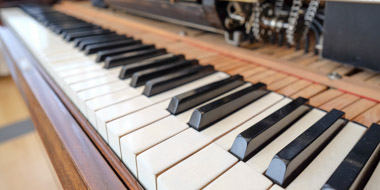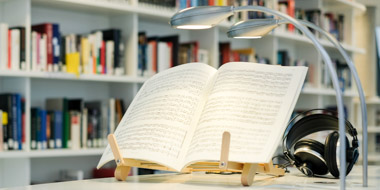Special collections

Historic sound reproduction devices

What use is the biggest treasury of sound recordings if you can’t play them? The German Music Archive has the right sound reproduction device for every record, disc, cylinder, roll and tape: from phonograph to Tefifon, from gramophone to laser disc player, from self-playing piano to disc music box. Some of these consist solely of a delicate mechanism, others are solid items of furniture. We have assembled the sound reproduction industry’s most beautiful and innovative inventions in our exhibition “From Edison Cylinder to Blu-Ray”. You can experience some of the exhibits in action during our guided tours of the German Music Archive.
Special legacies
Lale Andersen
Lale Andersen (1905–1972) was a German singer and actress. She became world-famous for her rendition of “Lili Marleen”, which was released in 1939 and sold a million times over. Her estate includes
- 80 song texts including some little-known contributions, e.g. from Axel Eggebrecht and Erich Kästner,
- orchestral parts for her most popular songs,
- tour programmes,
- newspaper articles and correspondence with publishers such as Ralph Maria Siegel and Peter Schaeffers.
Eberhard von Berswordt
Eberhard von Berswordt was a programme planner and head of department at Bayerischer Rundfunk for many years and specialised in dance and film music. From his estate, the German Music Archive received
- 14,000 shellac records and LPs, company catalogues,
- documentation relating to foreign releases by German artists (jazz and light music),
- a bequest from Jimmy Jungermann (jazz recordings and 100 original Walt Disney LPs).
Franz Hutter
Franz Hutter was a Swiss music teacher and collector who mainly specialised in classical music and rare vocal parts. From his estate, the German Music Archive holds more than 56,000 records from all genres, from the Emil Berliner gramophone record to the end of the shellac era (1896 to approx. 1956). A large part of this collection encompasses theatre, cabaret and film recordings, both spoken and musical.
Thomas Mann
Thomas Mann (1875–1955) was not only one of the most important writers of the 20th century, but also a great music lover. The German Music Archive holds part of his musical estate: 132 shellac records, mostly of works by Richard Wagner, which he took with him into exile in the USA.
Ernst Odrich
Ernst Odrich was a board member of VOX-Schellackplatten- und Sprechmaschinen-x in Berlin, which sold shellac records, wax cylinders and the relevant sound reproduction devices between 1920 and 1929. The German Music Archive holds a number of rare 17.5 cm shellac records from his estate. Some of them have portrait imprints and no central hole, which means they can only be played on a special turntable.
MIZ GDR

In 1991, the German Music Archive became home to an important special collection: the holdings of the Music Information Centre of the GDR’s Association of Composers and Musicologists (MIZ). This collection comprises
- more than 35,000 compositions,
- programmes,
- reviews,
- orchestral and theatrical performance calendars,
- analyses
- and photos.
Together with 10,000 recordings and 1,000 scores, this holding represents 40 years of GDR music history. We have digitised the material in order to make media at risk of disintegration available to users.
If you wish to use the collection, please notify us in advance by calling or writing to us:
info-dma@dnb.de
Phone +49 341 2271-150
Last changes:
07.06.2019
Contact:
info-dma@dnb.de




